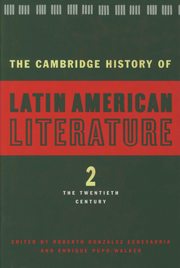Book contents
- Frontmatter
- Introduction to Volume 2
- 1 Modernist poetry
- 2 Modernist prose
- 3 The Vanguardia and its implications
- 4 The literature of Indigenismo
- 5 Afro-Hispanic American literature
- 6 The Criollista novel
- 7 The novel of the Mexican Revolution
- 8 The Spanish American novel from 1950 to 1975
- 9 The Spanish American novel: recent developments, 1975 to 1990
- 10 Spanish American poetry from 1922 to 1975
- 11 The modern essay in Spanish America
- 12 Literary criticism in Spanish America
- 13 The autobiographical narrative
- 14 The twentieth-century short story in Spanish America
- 15 Spanish American theatre in the twentieth century
- 16 Latin American (Hispanic Caribbean) literature written in the United States
- 17 Chicano literature
- Index
- Bibliographies
- References
16 - Latin American (Hispanic Caribbean) literature written in the United States
Published online by Cambridge University Press: 28 March 2008
- Frontmatter
- Introduction to Volume 2
- 1 Modernist poetry
- 2 Modernist prose
- 3 The Vanguardia and its implications
- 4 The literature of Indigenismo
- 5 Afro-Hispanic American literature
- 6 The Criollista novel
- 7 The novel of the Mexican Revolution
- 8 The Spanish American novel from 1950 to 1975
- 9 The Spanish American novel: recent developments, 1975 to 1990
- 10 Spanish American poetry from 1922 to 1975
- 11 The modern essay in Spanish America
- 12 Literary criticism in Spanish America
- 13 The autobiographical narrative
- 14 The twentieth-century short story in Spanish America
- 15 Spanish American theatre in the twentieth century
- 16 Latin American (Hispanic Caribbean) literature written in the United States
- 17 Chicano literature
- Index
- Bibliographies
- References
Summary
Hispanic Caribbean literature written in the United States is a relatively new field in literary history and criticism. In recent years, Spanish American literature written in the United States has become a reality because of writers who, for economic or political reasons, left their countries to reside in the United States. Authors such as Reinaldo Arenas (Cuba) and Sylvia Molloy (Argentina) write about their homelands; but, as their stay in the United States becomes more permanent, these and other authors such as Luisa Valenzuela (Argentina) and Carlos Guillermo Wilson (Panama) tend to document their experiences in a new environment. They are contributing to an existing body of Hispanic American literature written by Chicanos such as Rodolfo Anaya and Gary Soto, Puerto Ricans such as Nicholasa Mohr and Tato Laviera, and Cuban Americans such as Oscar Hijuelos and Ricardo Pau-Llosa, who write and live in cities like New York, Los Angeles, Miami, and Newark, which have now acquired a distinctly Hispanic character.
Hispanic Caribbean literature written in the United States has profited from the publicity received by the so-called Boom of the Latin American novel, which during the 1960s brought Latin American literature to the attention of a world reader. At the same time, Hispanic Caribbean narrative written in the United States appeals to a wide audience which includes English-speaking readers living on the North American continent. Political events have helped to promote aspects of this literature. During the turbulent decade of the 1960s, the Civil Rights and Black Power movements and Young Lords Party drew attention to the plight of Blacks and Hispanics in the United States.
- Type
- Chapter
- Information
- The Cambridge History of Latin American Literature , pp. 526 - 556Publisher: Cambridge University PressPrint publication year: 1996
References
- 1
- Cited by



